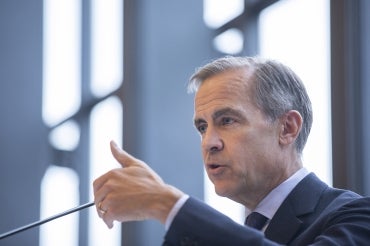Boosting education will help address short-term economic pain of AI, Mark Carney tells U of T audience

Published: October 24, 2018
The revolution spawned by artificial intelligence and machine learning will – like previous industrial revolutions – hurt employment and wage levels in the short term, Bank of England Governor Mark Carney told a University of Toronto audience on Tuesday. But in the long run, he said, productivity gains will kick in and employment levels will recover, if historical precedents are a guide.
Carney, a former Bank of Canada governor, was speaking at the fourth annual conference on Machine Learning and the Market for Intelligence organized by the Creative Destruction Lab at U of T’s Rotman School of Management. About 600 attendees packed Desautels Hall for a full day of presentations examining the business opportunities and economic implications of artificial intelligence. This year's conference focused on the “complements” needed to ensure that productivity gains from AI are realized: the infrastructure, training, regulation, data and judgment that must be present, in addition to the algorithms.
Carney told the crowd that in the three earlier industrial revolutions – where the world shifted to steam-driven technology, then to electricity, then to digital technologies – it took time for productivity gains to arrive, and then there was “a lag between the pickup in productivity and the pickup in wages.” Indeed, he noted that in the first industrial revolution’s shift to the age of steam, it took multiple generations for wages in the United Kingdom to catch up to earlier levels. Over time, however, the economy balances itself out and “in the end the economy ends up in a more productive place with everybody working.”
The problem with the current, fourth industrial revolution, he said, is that it is coming fast on the heels of the earlier shift to digitalization, which has already generated big productivity gains but where job benefits are not fully in place. One result of digitalization, he said, was the rapid growth of low-skill and high-skill jobs, along with a “hollowing out of mid-range skills.” Mid-range workers then competed for low-end jobs, depressing wages.
A key solution for dealing with these issues in the age of artificial intelligence is to boost levels of education, as was the case with each earlier industrial revolution. Businesses have a central role in identifying what skills are needed, and helping with retraining, Carney said. But governments also have to participate, because individuals are going to need public support if they take time off work in mid-career for added education.
Kevin Sneader, global managing partner at McKinsey & Co., told the conference that expectations for productivity gains from AI are still ahead of the reality. He projects it will take another decade for AI to achieve a true tipping point, where it will “reach the kind of penetration that digital enjoys today.” The sectors that will be the quickest to implement machine intelligence are generally the same ones that are already strong in the digital world, Sneader said. At the top of the list are the technology sector and telecommunications, the automotive and assembly business, and financial services.
Some other conference participants provided insights into the current state of artificial intelligence and machine learning in their organizations, and how these advances are already boosting productivity in the real world. Michael Evans, president of China-based e-commerce giant Alibaba Group, said AI is fundamental to the company’s ability to grow beyond its already massive operation, which connects more than 600 million users with 11 million merchants, and delivers 60 million packages per day.
The data generated from billions of transactions, combined with sophisticated algorithms, drives the artificial intelligence systems that allow Alibaba to customize each customer’s online shopping experience, run an enormous automated “smart” warehouse with 500 robots, and use “chatbots" to answer 95 per cent of the billions of customer queries the firm receives each week.
Linda Hasenfratz, CEO of manufacturer Linamar Corp., told the conference that machine learning and artificial intelligence are key means for her company to become more efficient and innovative. Crucial data is now gleaned from sensors in the manufacturing process, helping streamline operations, and AI-driven vision systems, rather than human inspectors, help discover defects. Data analytics and AI are increasingly used for tasks as wide-ranging as equipment selection and employee promotion, she said. In the case of Linamar, Hasenfratz insisted, automation and machine learning have not dented employment, but have boosted wages overall and made jobs more interesting.
In his presentation, Carney outlined some of the possibilities for greater use of artificial intelligence in the financial sector, where investment in AI is expected to quadruple in the next few years. Already, machine learning is automating credit decisions for mortgages and retail lending, directing robo-advisers, and verifying identification. But, Carney said, there is huge potential for using AI to guide lending to small and medium-sized businesses, which at the moment is an underserved market ripe for AI-driven efficiencies.



